New York Center for Facial Plastic Surgery
Schedule a consultation

Information about Trauma Reconstruction Surgery with Dr. Andrew Jacono in New York, NY.
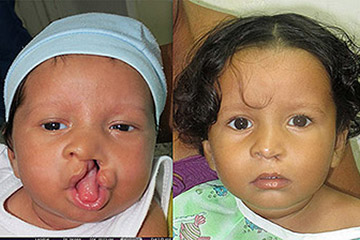
Facial disfigurement can occur in a fraction of a second but cause lifelong emotional and physical scars. Although prompt treatment in the emergency room can be integral to survival, permanent wounds can be unsightly.
A large portion of Dr. Jacono’s practice is dedicated to treating patients who have experienced facial trauma. During the first consultation, he evaluates the thickness, texture, and color of scars before deciding on the best surgical techniques. He then tactfully removes these scars and rebalances facial features with innovative tissue rearrangement.
Facial reconstructive surgery aims to restore damaged facial areas. Dr. Jacono is a specialist in various types of reconstructive surgery. His examination focuses on a number of things, including functional abnormalities like facial weakness, smiling, or chewing difficulties, and corneal exposure.
Usually, aesthetic restoration involves removing scars and rebalancing facial features through tissue rearrangement. If the face’s bones have been severely damaged, Dr. Jacono uses three-dimensional computer imaging to guide his process. Using this method, Dr. Jacono can use the patient’s own bodily tissues (e.g., bone, cartilage, and skin) to recreate facial shape and symmetry.
After reconstructive surgery, patients are taught camouflage techniques by a skilled makeup artist. This will help them hide specific blemishes. Dr. Jacono also asks an aesthetician to formulate a blended foundation that matches the patient’s skin tone. This will hide residual scarring.
Both cleft lip and cleft palate deformities cause difficulties with eating, drinking, speaking, and tooth formation. Luckily, these conditions can be treated surgically. Surgery is usually performed when patients are between 6 and 12 months old, as earlier intervention promotes normal development.
Secondary restorative surgery, as well as scar revision, is initiated several weeks to months after injury. After the initial consultation, Dr. Jacono outlines a surgical protocol to restore symmetry and uses the most sophisticated techniques available. Although persistent scars sometimes cannot be avoided, sophisticated laser technology can camouflage and flatten them.
In more extreme cases where trauma has penetrated the facial muscles or severed the facial nerve, microsurgical techniques can restore expression.
New York Center for Facial Plastic Surgery
Schedule a consultation

There are many reasons why people undergo plastic surgery. Some wish to tweak parts of their face that they are unhappy with. Others want to look younger or more attractive.
Still, others opt for plastic surgery after experiencing mild or severe facial trauma, which includes:
Patients who suffer from penetrating facial injuries should be treated by a facial plastic surgeon. For small to moderate scars, surgeons may cut away tissue, thoroughly irrigated with saline solution, and close the wound. In other cases, the surgeon may use a skin graft or flap to smooth the area.
Facial deformities are aesthetic and functional defects present at birth. There are many facial abnormalities, but the most common include cleft lip and cleft palate deformities.
A cleft lip is an opening in the upper lip that occurs when facial structures don’t properly develop.
A cleft palate is a fissure in the soft palate that also occurs when certain facial structures don’t connect. Many patients are born with either a cleft lip or a cleft palate, but some are unfortunately born with both.
Both cleft lip and cleft palate deformities cause difficulties with eating, drinking, speaking, and tooth formation. Luckily, these conditions can be treated surgically. Surgery is usually performed when patients are between 6 and 12 months old, as earlier intervention promotes normal development.
Dog bites account for more than 800,000 emergency room visits per year. Bites are different from other lacerations in that the incidence of infection is 15 times higher. This is because dog saliva contains a combination of viral and bacterial contaminants. Penetrating injuries can even lead to a late infection that presents as fever, redness, and swelling.
Anyone with a dog bite bigger than a scratch should seek medical attention immediately. Initial treatment should include a thorough cleansing, antibiotics, and tetanus prophylaxis. Dog bites should also be reported to the Health Department to ascertain whether the dog has had a rabies vaccine.
Serious facial dog bites should be treated by a plastic surgeon. A repair usually entails cutting away contaminated tissue and irrigating the area with an antibiotic solution. Freshened skin edges are then closed. 40% of all dog bites include torn flesh, which requires the plastic surgeon to replace lost tissue.
Recovery after facial reconstruction differs based on the severity of the trauma and the technique used to address it. However, in most cases, it takes 5 to 7 days for swelling to resolve. It also takes 10 to 14 days for bruising to fade.
If the lips have been reconstructed, it may be difficult to eat at first. If the cheeks have been reconstructed, it may be hard to make normal expressions.

Dr. Jacono is a dual board-certified facial plastic and reconstructive surgeon with over 20 years of experience. He has extensive training in all types of trauma reconstruction surgery and delivers the most comprehensive results possible.
To see if you are a candidate for reconstructive surgery with Dr. Jacono, please contact his offices in either Manhattan or on Long Island.
Dr. Jacono performed lower lip reconstruction following a tramatic dog bite.
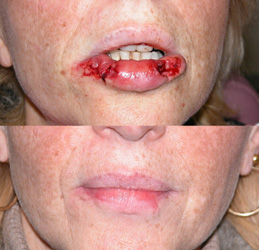
This patient has a keloid of the ear from prior ear piercings through the ear cartilage. Correction required removal of the keloid with skin grafting.
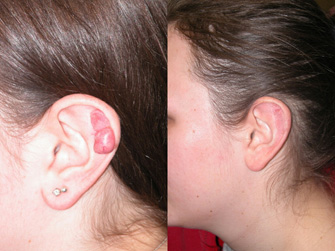
Lower Lip Reconstruction After Dog Bite.
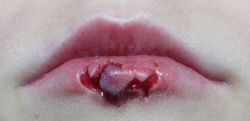
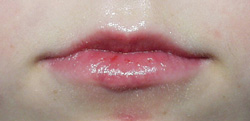

Accessibility: If you are vision-impaired or have some other impairment covered by the Americans with Disabilities Act or a similar law, and you wish to discuss potential accommodations related to using this website, please contact our Accessibility Manager at (212) 570-2500 .